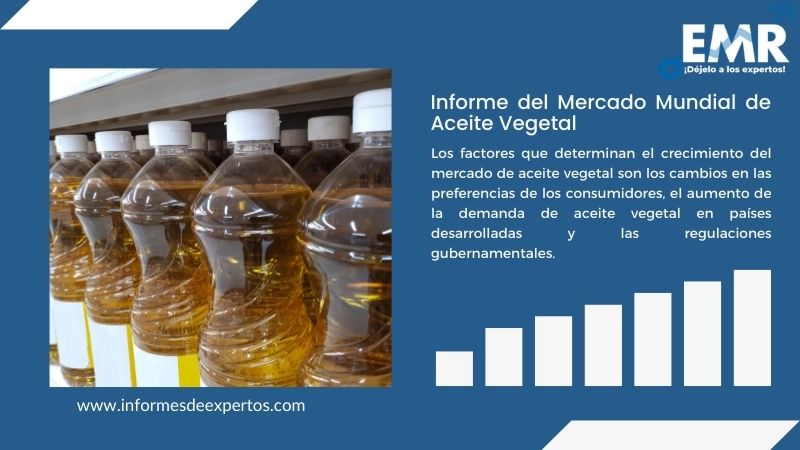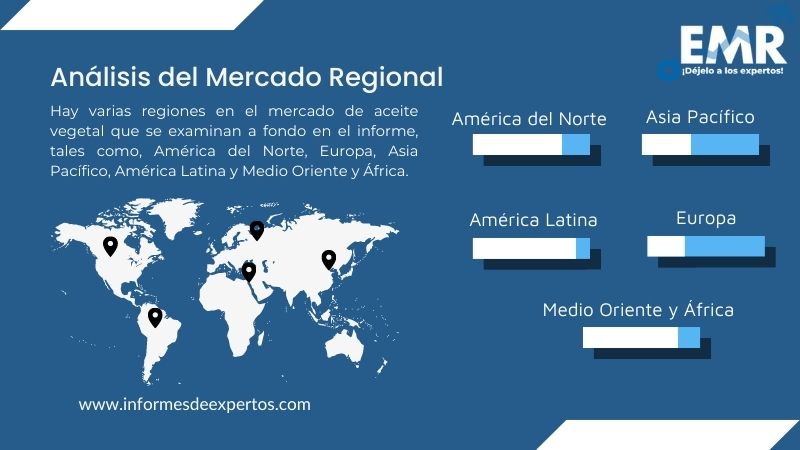Informes

Mercado Global de Aceite Vegetal – Por Tipo de Aceite (Aceite de Palma, Soja, Canola, Girasol, Coco, Oliva, Otros); Por Aplicación ( Alimentos, Piensos, Industrial); Por Región (América del Norte, Europa, Asia Pacífico, América Latina, Medio Oriente y África); Dinámica del Mercado (2026-2035) y Panorama Competitivo
Perspectiva del Mercado de Aceite Vegetal
En 2025, el mercado del aceite vegetal alcanzó un volumen aproximado de 226,70 MMT. Se estima que el mercado crezca a una TCAC del 3,10% de 2026 a 2035, para alcanzar un volumen aproximado 308 MMT en 2035.

Informe de muestra gratuito con índice: Obtenga un informe de muestra gratuito con tabla de contenido
Análisis del Mercado de Aceite Vegetal
El mercado de los aceites vegetales está en auge debido a la creciente preferencia por aceites más saludables, como el aceite de oliva y el de aguacate, frente a los aceites vegetales tradicionales. A nivel mundial, el aceite de soja es actualmente el más producido y consumido, seguido del aceite de palma y de colza. Según los datos del Departamento de Agricultura de Estados Unidos (USDA) en 2023/2024, la producción de aceite de soja en China alcanzó un volumen de alrededor de 17,74 millones de toneladas métricas mientras que la producción de aceite de palma en Indonesia alcanzó un volumen de alrededor de 43 millones de toneladas métricas.
El aumento del veganismo ha impulsado la demanda de productos de origen vegetal, incluidos los aceites vegetales, lo que a su vez ha contribuido al crecimiento del mercado. Según los informes de la industria, en 2023, había alrededor de 276.000 veganos en España. Con el aumento de la demanda de aceite vegetal, los fabricantes están explorando fuentes alternativas de aceite, como las algas, la canola y la mostaza, que a su vez influyen en las perspectivas del mercado de aceites vegetales.
La exportación de aceites vegetales en todo el mundo ha aumentado en los últimos años, lo que a su vez ha desempeñado un papel importante en la expansión del mercado de aceites vegetales. En 2021, las exportaciones de aceite de soja fueron de alrededor de USD 17,8 mil millones, que aumentaron en 2022 a alrededor de USD 19,7 mil millones. Además, en 2022, España exportó aceite de oliva por valor de alrededor de 3,22 millones de dólares a todo el mundo. El país exportó aceite de oliva principalmente a países como Estados Unidos, Italia y México, entre otros.
Principales Tendencias y Factores del Mercado de Aceites Vegetales
Aumento de la demanda de aceite vegetal en las industrias de uso final
La cuota de mercado del aceite vegetal está aumentando debido a su creciente uso en diversas industrias, como la alimentaria, la cosmética y la farmacéutica. En la industria alimentaria, el aceite vegetal se utiliza para cocinar, hornear y freír, así como en la producción de alimentos procesados. Según datos de la North America Olive Oil Association, el consumo de aceite de oliva en España e Italia ronda los 15 y 13 litros/persona/año, respectivamente.
En la industria cosmética, el aceite vegetal se utiliza como ingrediente en productos para el cuidado de la piel y el cabello. El aceite de coco, el aceite de oliva y el aceite de ricino, entre otros, son algunos de los aceites vegetales más populares que se utilizan en los productos cosméticos por sus propiedades antiinflamatorias y antibacterianas.
Creciente popularidad de los aceites vegetales de origen sostenible
El aumento de la conciencia medioambiental y la creciente preocupación por la salud entre los consumidores impulsan la demanda de aceites vegetales de origen sostenible, lo que a su vez contribuye al crecimiento del mercado de aceites vegetales. Para satisfacer esta demanda, los fabricantes producen el aceite vegetal sin utilizar pesticidas sintéticos, herbicidas ni fertilizantes químicos. Además, para atraer a consumidores más concienciados con la ecología, los principales actores del sector del aceite vegetal obtienen cada vez más certificaciones y se adhieren a normas como la Mesa Redonda sobre el Aceite de Palma Sostenible (RSPO) para el aceite de palma, el Comercio Justo para diversos aceites y la certificación USDA Organic para los aceites vegetales ecológicos.
Incremento de las iniciativas gubernamentales en apoyo de la industria de aceites vegetales
El mercado del aceite vegetal está impulsado por las crecientes iniciativas gubernamentales para fomentar la producción, importación y exportación de aceites vegetales. En septiembre de 2023, el gobierno de India aumentó los aranceles a la importación de aceite de palma y otros aceites comestibles para apoyar a los agricultores locales de semillas oleaginosas y reducir las importaciones. El derecho de importación del aceite de palma crudo pasó del 5,5% al 27,5% y el del aceite de palma refinado del 13,75% al 37,75 %.
Segmentación del Mercado de Aceite Vegetal

Informe de muestra gratuito con índice: Obtenga un informe de muestra gratuito con tabla de contenido
Por tipo de aceite, el mercado se clasifica en:
- Aceite de Palma
- Aceite de Soja
- Aceite de Canola
- Aceite de Girasol
- Aceite de Coco
- Aceite de Oliva
- Otros
Por aplicaciones, el mercado del aceite vegetal se divide en:
- Alimentos
- Piensos
- Industrial
- Otros
Hay varias regiones en el mercado de aceite vegetal que se examinan a fondo en el informe, tales como, América del Norte, Europa, Asia Pacífico, América Latina y Medio Oriente y África.

Informe de muestra gratuito con índice: Obtenga un informe de muestra gratuito con tabla de contenido
Panorama Competitivo
El mercado de aceite vegetal está experimentando nuevos cambios, ya que los principales actores se están centrando más en un mayor nivel de producción. También están introduciendo nuevos cambios en términos de adopción de tecnología avanzada y selección de mejores métodos. Los principales actores mundiales analizados en el informe son:
- Cargill, Incorporated
- Archer Daniel Midland Company
- IOI Corporation Berhad (IOI)
- Fuji Oil Co., Ltd.
- Sime Darby Plantation Berhad
- Bunge Limited
- Wilmar International Limited
- Louis Dreyfus Company B.V.
- Conagra Brands, Inc
- Olam Group Limited
- Golden Agri-Resources (GAR)
- PT Astra Agro Lestari Tbk
- Otros
El informe de Informes de Expertos (IDE) examina el mercado global de aceite vegetal proyectando los factores de progresión durante los períodos histórico (2019-2025) y pronóstico (2026-2035). Igualmente, destaca las tendencias que favorecen al análisis del mercado basado en tipo de aceite, aplicación, y las regiones clave. El estudio presenta la dinámica competitiva de la industria objetiva sobre la base de las Cinco Fuerzas de Porter y el análisis FODA. Además, el informe rastrea las tendencias históricas y futuristas que se espera que configuren la perspectiva del mercado.
Alcance del Mercado
|
Características del Informe |
Detalles |
|
Año Base de la Estimación: |
2025 |
|
Datos Históricos: |
2019-2025 |
|
Datos de Pronóstico: |
2026-2035 |
|
Alcance del Informe: |
Tendencias Históricas y Previsiones del Mercado, Impulsores y Limitantes de
|
|
Desglose por |
|
|
Desglose por Aplicación: |
|
|
Desglose por Región: |
|
|
Dinámica del Mercado: |
|
|
Análisis de Datos Comerciales: |
|
|
Análisis de Precios: |
|
|
Panorama Competitivo: |
|
|
Empresas Cubrietas: |
|
Informes relacionados:
Mercado Latinoamericano de Aceite Vegetal
Mercado de Aceite Vegetal en Perú
Mercado de Aceite de Palma en México
Mercado del Aceite de Palma en Brasil
*En Informes de Expertos siempre nos esforzamos por brindarle la información más reciente. Los números de artículo son solo indicativos y pueden diferir del informe real.
Language of the Report – English
Sin embargo, el informe puede estar disponible en español por un costo adicional.
1 Preface
2 Report Coverage – Key Segmentation and Scope
3 Report Description
3.1 Market Definition and Outlook
3.2 Properties and Applications
3.3 Market Analysis
3.4 Key Players
4 Key Assumptions
5 Executive Summary
5.1 Overview
5.2 Key Drivers
5.3 Key Developments
5.4 Competitive Structure
5.5 Key Industrial Trends
6 Market Snapshot
6.1 Global
6.2 Regional
7 Opportunities and Challenges in the Market
8 Global Vegetable Oil Market Analysis
8.1 Key Industry Highlights
8.2 Global Vegetable Oil Historical Market (2019-2025)
8.3 Global Vegetable Oil Market Forecast (2026-2035)
8.4 Global Vegetable Oil Market by Oil Type
8.4.1 Palm Oil
8.4.1.1 Historical Trend (2019-2025)
8.4.1.2 Forecast Trend (2026-2035)
8.4.2 Soyabean Oil
8.4.2.1 Historical Trend (2019-2025)
8.4.2.2 Forecast Trend (2026-2035)
8.4.3 Sunflower Oil
8.4.3.1 Historical Trend (2019-2025)
8.4.3.2 Forecast Trend (2026-2035)
8.4.4 Olive Oil
8.4.4.1 Historical Trend (2019-2025)
8.4.4.2 Forecast Trend (2026-2035)
8.4.5 Canola Oil
8.4.5.1 Historical Trend (2019-2025)
8.4.5.2 Forecast Trend (2026-2035)
8.4.6 Coconut Oil
8.4.6.1 Market Share
8.4.6.2 Historical Trend (2019-2025)
8.4.6.3 Forecast Trend (2026-2035)
8.4.7 Others
8.5 Global Vegetable Oil Market by Application
8.5.1 Food
8.5.1.1 Historical Trend (2019-2025)
8.5.1.2 Forecast Trend (2026-2035)
8.5.2 Feed
8.5.2.1 Historical Trend (2019-2025)
8.5.2.2 Forecast Trend (2026-2035)
8.5.3 Industrial
8.5.3.1 Historical Trend (2019-2025)
8.5.3.2 Forecast Trend (2026-2035)
8.6 Global Vegetable Oil Market by Region
8.6.1 North America
8.6.1.1 Historical Trend (2019-2025)
8.6.1.2 Forecast Trend (2026-2035)
8.6.2 Europe
8.6.2.1 Historical Trend (2019-2025)
8.6.2.2 Forecast Trend (2026-2035)
8.6.3 Asia Pacific
8.6.3.1 Historical Trend (2019-2025)
8.6.3.2 Forecast Trend (2026-2035)
8.6.4 Latin America
8.6.4.1 Historical Trend (2019-2025)
8.6.4.2 Forecast Trend (2026-2035)
8.6.5 Middle East and Africa
8.6.5.1 Historical Trend (2019-2025)
8.6.5.2 Forecast Trend (2026-2035)
9 North America Vegetable Oil Market Analysis
9.1 Market by Oil Type
9.2 Market by Application
9.3 Market by Country
9.3.1 United States of America
9.3.1.1 Historical Trend (2019-2025)
9.3.1.2 Forecast Trend (2026-2035)
9.3.2 Canada
9.3.2.1 Historical Trend (2019-2025)
9.3.2.2 Forecast Trend (2026-2035)
10 Europe Vegetable Oil Market Analysis
10.1 Market by Oil Type
10.2 Market by Application
10.3 Market by Country
10.3.1 United Kingdom
10.3.1.1 Historical Trend (2019-2025)
10.3.1.2 Forecast Trend (2026-2035)
10.3.2 Germany
10.3.2.1 Historical Trend (2019-2025)
10.3.2.2 Forecast Trend (2026-2035)
10.3.3 France
10.3.3.1 Historical Trend (2019-2025)
10.3.3.2 Forecast Trend (2026-2035)
10.3.4 Italy
10.3.4.1 Historical Trend (2019-2025)
10.3.4.2 Forecast Trend (2026-2035)
10.3.5 Others
11 Asia Pacific Vegetable Oil Market Analysis
11.1 Market by Oil Type
11.2 Market by Application
11.3 Market by Country
11.3.1 China
11.3.1.1 Historical Trend (2019-2025)
11.3.1.2 Forecast Trend (2026-2035)
11.3.2 Japan
11.3.2.1 Historical Trend (2019-2025)
11.3.2.2 Forecast Trend (2026-2035)
11.3.3 India
11.3.3.1 Historical Trend (2019-2025)
11.3.3.2 Forecast Trend (2026-2035)
11.3.4 ASEAN
11.3.4.1 Historical Trend (2019-2025)
11.3.4.2 Forecast Trend (2026-2035)
11.3.5 South Korea
11.3.5.1 Historical Trend (2019-2025)
11.3.5.2 Forecast Trend (2026-2035)
11.3.6 Australia
11.3.6.1 Historical Trend (2019-2025)
11.3.6.2 Forecast Trend (2026-2035)
11.3.7 Others
12 Latin America Vegetable Oil Market Analysis
12.1 Market by Oil Type
12.2 Market by Application
12.3 Market by Country
12.3.1 Brazil
12.3.1.1 Historical Trend (2019-2025)
12.3.1.2 Forecast Trend (2026-2035)
12.3.2 Argentina
12.3.2.1 Historical Trend (2019-2025)
12.3.2.2 Forecast Trend (2026-2035)
12.3.3 Mexico
12.3.3.1 Historical Trend (2019-2025)
12.3.3.2 Forecast Trend (2026-2035)
12.3.4 Others
13 Middle East and Africa Vegetable Oil Market Analysis
13.1 Market by Oil Type
13.2 Market by Application
13.3 Market by Country
13.3.1 Saudi Arabia
13.3.1.1 Historical Trend (2019-2025)
13.3.1.2 Forecast Trend (2026-2035)
13.3.2 United Arab Emirates
13.3.2.1 Historical Trend (2019-2025)
13.3.2.2 Forecast Trend (2026-2035)
13.3.3 Nigeria
13.3.3.1 Historical Trend (2019-2025)
13.3.3.2 Forecast Trend (2026-2035)
13.3.4 South Africa
13.3.4.1 Historical Trend (2019-2025)
13.3.4.2 Forecast Trend (2026-2035)
13.3.5 Others
14 Market Dynamics
14.1 SWOT Analysis
14.1.1 Strengths
14.1.2 Weaknesses
14.1.3 Opportunities
14.1.4 Threats
14.2 Porter’s Five Forces Analysis
14.2.1 Supplier’s Power
14.2.2 Buyer’s Power
14.2.3 Threat of New Entrants
14.2.4 Degree of Rivalry
14.2.5 Threat of Substitutes
14.3 Key Indicators for Demand
14.4 Key Indicators for Price
15 Value Chain Analysis
16 Trade Data Analysis
16.1 Major Importing Countries
16.1.1 By Volume
16.1.2 By Value
16.2 Major Exporting Countries
16.2.1 By Volume
16.2.2 By Value
17 Price Analysis
17.1 North America Historical Price Trends (2019-2025) and Forecast (2026-2035)
17.2 Europe Historical Price Trends (2019-2025) and Forecast (2026-2035)
17.3 Asia Pacific Historical Price Trends (2019-2025) and Forecast (2026-2035)
17.4 Latin America Historical Price Trends (2019-2025) and Forecast (2026-2035)
17.5 Middle East and Africa Historical Price Trends (2019-2025) and Forecast (2026-2035)
18 Competitive Landscape
18.1 Market Structure
18.2 Company Profiles
18.2.1 Cargill, Incorporated
18.2.1.1 Company Overview
18.2.1.2 Product Portfolio
18.2.1.3 Demographic Reach and Achievements
18.2.1.4 Certifications
18.2.2 Archer Daniel Midland Company
18.2.2.1 Company Overview
18.2.2.2 Product Portfolio
18.2.2.3 Demographic Reach and Achievements
18.2.2.4 Certifications
18.2.3 IOI Corporation Berhad (IOI)
18.2.3.1 Company Overview
18.2.3.2 Product Portfolio
18.2.3.3 Demographic Reach and Achievements
18.2.3.4 Certifications
18.2.4 Fuji Oil Co., Ltd.
18.2.4.1 Company Overview
18.2.4.2 Product Portfolio
18.2.4.3 Demographic Reach and Achievements
18.2.4.4 Certifications
18.2.5 Sime Darby Plantation Berhad
18.2.5.1 Company Overview
18.2.5.2 Product Portfolio
18.2.5.3 Demographic Reach and Achievements
18.2.5.4 Certifications
18.2.6 Bunge Limited
18.2.6.1 Company Overview
18.2.6.2 Product Portfolio
18.2.6.3 Demographic Reach and Achievements
18.2.6.4 Certifications
18.2.7 Wilmar International Limited
18.2.7.1 Company Overview
18.2.7.2 Product Portfolio
18.2.7.3 Demographic Reach and Achievements
18.2.7.4 Certifications
18.2.8 Louis Dreyfus Company B.V.
18.2.8.1 Company Overview
18.2.8.2 Product Portfolio
18.2.8.3 Demographic Reach and Achievements
18.2.8.4 Certifications
18.2.9 Conagra Brands, Inc
18.2.9.1 Company Overview
18.2.9.2 Product Portfolio
18.2.9.3 Demographic Reach and Achievements
18.2.9.4 Certifications
18.2.10 Olam Group Limited
18.2.10.1 Company Overview
18.2.10.2 Product Portfolio
18.2.10.3 Demographic Reach and Achievements
18.2.10.4 Certifications
18.2.11 Golden Agri-Resources (GAR)
18.2.11.1 Company Overview
18.2.11.2 Product Portfolio
18.2.11.3 Demographic Reach and Achievements
18.2.11.4 Certifications
18.2.12 PT Astra Agro Lestari Tbk
18.2.12.1 Company Overview
18.2.12.2 Product Portfolio
18.2.12.3 Demographic Reach and Achievements
18.2.12.4 Certifications
18.2.13 Others
19 Key Trends and Developments in the Market
List of Key Figures and Tables
1. Global Vegetable Oil Market: Key Industry Highlights, 2019 and 2035
2. Global Vegetable Oil Historical Market: Breakup by Oil Type (MMT), 2019-2025
3. Global Vegetable Oil Market Forecast: Breakup by Oil Type (MMT), 2026-2035
4. Global Vegetable Oil Historical Market: Breakup by Application (MMT), 2019-2025
5. Global Vegetable Oil Market Forecast: Breakup by Application (MMT), 2026-2035
6. Global Vegetable Oil Historical Market: Breakup by Region (MMT), 2019-2025
7. Global Vegetable Oil Market Forecast: Breakup by Region (MMT), 2026-2035
8. North America Vegetable Oil Historical Market: Breakup by Country (MMT), 2019-2025
9. North America Vegetable Oil Market Forecast: Breakup by Country (MMT), 2026-2035
10. Europe Vegetable Oil Historical Market: Breakup by Country (MMT), 2019-2025
11. Europe Vegetable Oil Market Forecast: Breakup by Country (MMT), 2026-2035
12. Asia Pacific Vegetable Oil Historical Market: Breakup by Country (MMT), 2019-2025
13. Asia Pacific Vegetable Oil Market Forecast: Breakup by Country (MMT), 2026-2035
14. Latin America Vegetable Oil Historical Market: Breakup by Country (MMT), 2019-2025
15. Latin America Vegetable Oil Market Forecast: Breakup by Country (MMT), 2026-2035
16. Middle East and Africa Vegetable Oil Historical Market: Breakup by Country (MMT), 2019-2025
17. Middle East and Africa Vegetable Oil Market Forecast: Breakup by Country (MMT), 2026-2035
18. Major Importing Countries by Volume
19. Major Exporting Countries by Volume
20. Major Importing Countries by Value
21. Major Exporting Countries by Value
22. North America Historical Price Trends and Forecast 2019-2035
23. Europe Historical Price Trends and Forecast 2019-2035
24. Asia Pacific Historical Price Trends and Forecast 2019-2035
25. Latin America Historical Price Trends and Forecast 2019-2035
26. Middle East and Africa Historical Price Trends and Forecast 2019-2035
27. Global Vegetable Oil Market Structure
¿Cuál fue el volumen obtenido por el mercado de aceite vegetal en 2025 a nivel mundial?
A nivel mundial, el mercado registró un volumen de mercado de aceite vegetal de 226,70 MMT en 2025.
¿Cuál sería la CAGR que se espera que obtenga el mercado de aceite vegetal durante el periodo 2026-2035 en el mundo?
Se prevé que el mercado de aceite vegetal obtenga una tasa de crecimiento anual compuesto de aproximadamente 3,10% durante el periodo pronóstico de 2026-2035 a nivel mundial.
¿Cuáles son los principales factores que aumentan el tamaño del mercado del aceite vegetal?
Los factores que determinan el crecimiento del mercado de aceite vegetal son los cambios en las preferencias de los consumidores con grandes preocupaciones por la salud, el aumento de la demanda de aceite vegetal en países desarrolladas y las regulaciones gubernamentales.
¿Cuáles son las principales tendencias del mercado de aceites vegetales?
El mercado de la contratación en línea está impulsado por varios factores que aumento de la demanda de productos de origen vegetal, cambio hacia versiones más saludables y avances tecnológicos.
¿Cuáles son los distintos tipos de aceite vegetal?
Existen diferentes tipos de aceite vegetal en el mercado, como el de palma, soja, canola, girasol, coco, oliva y otros.
¿Cuáles son las distintas aplicaciones del aceite vegetal?
Las aplicaciones de los aceites vegetales son alimentos, piensos e industrial.
¿Qué tipo de aceite domina el mercado de aceites vegetales?
El segmento de soja domina el mercado de aceite vegetal por los cambios hacia los aceites saludables.
¿Cuáles son las principales regiones incluidas en el informe sobre el mercado de aceite vegetal?
Las regiones que muestran los diferentes escenarios del mercado son América del Norte, Europa, Asia Pacífico, América Latina y Medio Oriente y África.
¿Cuáles son las principales empresas del mercado de aceites vegetales?
Bunge Limited, ADM, Cargill, Incorporated, Wilmar International Ltd., Louis Dreyfus Company, y otros son las mayores empresas.
¿Cuál es la perspectiva de pronóstico del mercado de aceite vegetal para 2026-2035?
Se espera que el mercado de aceite vegetal experimente un crecimiento sólido durante el periodo de pronóstico de 2026-2035 para alcanzar los 308 MMT para 2035.
Excel Data Set
USD1799
-
Datos completos en formato Excel para un usuario
-
Impresión no permitida
-
Entrega por Email
-
Personalización limitada gratuita (pre-venta)Soporte de analista post ventaDescuento del 50% en la Próxima ActualizaciónUsuario Único
USD3199
USD2999-
Restringido a un usuario
-
Solo una impresión
-
Disponible en PDF
-
Personalización limitada gratuita (pre-venta)Soporte de analista post ventaDescuento del 50% en la Próxima ActualizaciónCinco Usuarios
USD4199
USD3999-
Restringido a cinco usuarios
-
Una impresión por usuario
-
Disponible en PDF
-
Personalización limitada gratuita (pre-venta)
-
Soporte de analista post venta
-
Descuento del 50% en la Próxima Actualización
Multiusuario
USD5199
USD4999-
Usuarios ilimitados dentro de la organización
-
Impresiones ilimitadas
-
Disponible en PDF
-
Personalización limitada gratuita (pre-venta)
-
Soporte de analista post venta
-
Descuento del 50% en la Próxima Actualización
Póngase en Contacto¿Cualquier Pregunta? Hable con un Analista
Solicitar una MuestraVer una Muestra
Solicitar PersonalizaciónSe le olvidó algo? Pregunte Ahora
¿Por qué Informes de Expertos?La Gente Adecuada
Somos técnicamente excelentes, estratégicos, prácticos, experimentados y eficientes; nuestros analistas son cuidadosamente seleccionados en función de tener los atributos correctos para trabajar con éxito y ejecutar proyectos basados en sus expectativas.
Metodología Correcta
Aprovechamos nuestra tecnología de vanguardia, nuestro acceso a bases de datos confiables y nuestro conocimiento de los modelos actuales utilizados en el mercado para ofrecerle soluciones de investigación que se adapten a sus necesidades y lo pongan a la vanguardia.
Precio Justo
Realizamos una investigación exhaustiva y de calidad superior a precios razonables, inigualables y que demuestran nuestra comprensión de su estructura de recursos. Además, ofrecemos descuentos atractivos en nuestros próximos informes.
Apoyo Adecuado
Nuestro equipo de analistas expertos está a su disposición entera para ofrecerle resultados óptimos personalizados para satisfacer sus necesidades precisas dentro del plazo especificado y ayudarlo a comprender mejor la industria.
Informes SimilaresEl crecimiento del mercado del aceite de ricino en México está impulsado por el aumento de su demanda por parte de las diversas industrias de uso final y el incremento de las actividades de alcance ...
El mercado de aceite de palma en Perú está experimentando un crecimiento significativo debido a la creciente aplicación de aceite de palma en productos alimenticios, el aumento de la demanda de pro...
El crecimiento del mercado de aceite de palma en México está favorecido por el aumento de la conciencia sobre los beneficios para la salud del uso de aceite de palma en la cocina, el aumento de la d...
El mercado de aceite vegetal en Perú está experimentando un crecimiento constante debido al aumento del consumo de aceite de palma en la región, el aumento de la asequibilidad de los aceites vegeta...
El mercado de aceite de soja es impulsado por la creciente demanda en la industria de alimentos y bebidas, ya que realza el aroma, mejora la apariencia y la textura de los alimentos, y por lo tanto es...
Newsletter





